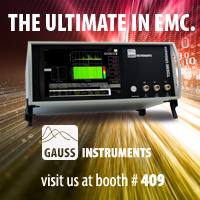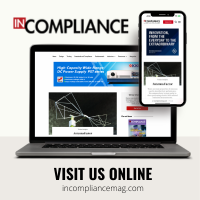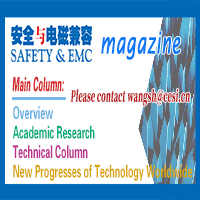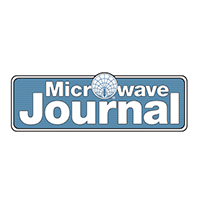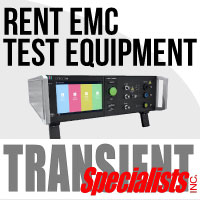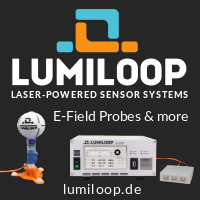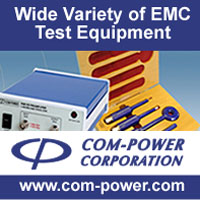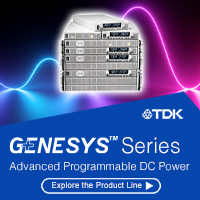Experiments & Demonstrations
You will not want to miss the popular Experiments and Demonstrations program that will be held in the Exhibition Hall. This hands-on activity provides a unique learning experience that complements the technical presentations at the symposium. It is traditionally one of the educational highlights of the annual symposium!
Date: Tuesday, August 6
Time: 10:00 AM – 12:00 PM
Location: Exhibit Hall
ED01 – Cracking the Shield: Noise Suppression Sheets (NSS) and Board Level Shielding (BLS) for your PCB
Location: E&D Booth 1
Presenter: Victor Martinez Garcia and Jared Quenzer, Wurth Electronik
Knowing which Noise Suppression Sheets has to be selected for your application in electromagnetic compatibility (EMC) and signal integrity, can be a tricky matter. Join our session for studying in focus on NSS, examining their composition, magnetic characteristics, the effect of different thicknesses. We will also provide a practical insights into the integration shielding solution for improving the board level shielding from your application with shielding cans or shielding cabinets, discussing the trade-offs between possible solutions.
Don’t miss our session where we unveil the cutting-edge wonders of Noise Suppression Sheet and Board Level Shielding
ED02 – Bulk Current Injection Technical Demonstration
Location: E&D Booth 2
Presenter: Sean Lynch, Rohde & Schwarz
The purpose of this demonstration titled “BCI Demo” is to show how to calculate and a achieve test levels with a BCI system for ISO 11451, MIL-STD-461G, and IEC 61000-4-6 test standards. We will work backwards given a test level, known transfer impedance from industry probes and equipment and then follow good practices to size generators and amplifiers accordingly (following an 80% rule).
The ease of setting up a test like this when there is a fully automated software that can control all instrumentation will also be highlighted during this demo. The goal is to see how close we can get to the reach measurements given the constraints we operate under.
ED03 – Using Low Cost Software Defined Radio (SDR) for EMC Investigations
Location: E&D Booth 3
Presenter: Karen Burnham, Electro Magnetic Applications, Inc.
Karen Burnham will demonstrate how different SDRs, costing between $20 – 200, can be used for EMC purposes. In particular, she will demonstrate using SDR dongles in combination with antennas and/or current probes to get a sense of the EM/RF environment in a particular area and potential trouble spots.
ED04 – Unveiling Time Domain Gating: Enhancing Control and Versatility with a Newly Developed Library
Location: E&D Booth 4
Presenter: Yibo Wang, ETS-Lindgren and Andrew Shyne, Boeing
Time domain gating is a well-known technique for isolating responses in reflective environments, commonly integrated into commercial vector network analyzers (VNAs). However, users often have limited options for further processing once data is downloaded from a VNA. To address this, a gating library has been developed which provides greater flexibility to users. This library can easily integrate with popular programming languages such as Matlab, Python, and C. Gated results often suffer from “band edge effects” due to limited measurement bandwidth. To mitigate this, the library incorporates standard edge treatment techniques and introduces a new Spectrum Extension Edgeless Gating (SEEG) method, significantly reducing edge effects compared to conventional methods. In addition, the library is not limited to time domain applications, but also performs well in spatial and spectrum analyses, such as image processing and antenna spectrum analyses. During demonstrations, real-time gating of antenna responses will be showcased, with parameters adjusted via Matlab script. Additionally, outputs from conventional edge renormalization and SEEG techniques will be compared to highlight the latter’s superiority in edge treatment. Furthermore, spectrum mode filtering for antenna extrapolation will be demonstrated, showing the library’s versatility beyond time-domain applications, utilizing data from the Boeing Dual Robotic Antenna Measurement System (DRAMS) for real-time gating in the angular spectrum domain.
Date: Tuesday, August 6
Time: 2:00 PM – 4:00 PM
Location: Exhibit Hall
ED05 – Common Mode – Where Does it Come From and How Can it Go Away?
Location: E&D Booth 1
Presenter: Patrick Andre, Andre Consulting, Inc.
We hear about common mode currents. The question becomes how are they generated, and why are they a problem? If they exist in a product, how do we control it? What works and what does not work? Through both teaching and demonstration, Mr. Andre will demonstrate each of these points.
ED06 – Visualization of Low Frequency EMI Using a Smartphone
Location: E&D Booth 2
Presenter: Kevin Claytor and Ashley Mowery, Johns Hopkins Applied Physics Laboratory
We will be demonstrating an application where we use a smartphone to map low frequency EMI. Data is captured through a magnetic sensor connected to the headphone jack and onboard GPS sensors. This data is then fused to provide a map of low frequency EMI up to 16 kHz. The map is dynamic and interactive, allowing one to view a heatmap of EMI or interrogate the EMI spectrum at a given point.
ED07 – The Challenge of Measuring a 40 uOhm (2000 Amp) PDN with a 2-Port Probe
Location: E&D Booth 3
Presenter: Benjamin Dannon, Signal Edge Solutions and Steve Sandler, California Miramar University, USA
The assessment of PDN impedance has become a well-published mantra. However, designing a power distribution network (PDN) for a scalable 2000 Amp power supply presents numerous challenges, one of which is measurement of the 2000A PDN.
Most of us are aware of the ground loop in the 2-port measurement. Most of us are also aware that we need to introduce a ground loop isolator to correct the error. If not, we’ve published plenty on the subject. But how much CMRR do you need to add? How does the use of a probe impact this requirement? The goal of this presentation is to demonstrate how one can effectively measure a 2000 Amp PDN or 40 uOhm using various VNAs. In addition to proving the need for CMRR rejection, discussion on how to calculate the minimum CMRR with a PDN impedance measurement using a 2-port probe will be shown. Lastly, it will be shown that it is possible to measure a sub-40 µΩ impedance using a 2-port probe, when using an isolator that has sufficient CMRR.
ED08 – Wi-Fi 6E/7: Amazing New Frontiers and Challenges…
Location: E&D Booth 4
Presenter: Bill Koerner, Keysight
Wireless connectivity has had such an impact on how we conduct our daily lives. With the wires removed, suddenly we are able to be connected to almost anyone, anywhere and anytime. According to a report released by IDC Research, 3.8 billion Wi-Fi devices were forecasted to be shipped in 2023. Over the last few years, the number and complexity of the Wi-Fi standards has grown. The U.S. opened up the 6 GHz band while the EU opened up about half of the 6 GHz bands for Wi-Fi 6E, and now Wi-Fi 7. Although the Wi-Fi 7 standard has yet to be formally adopted, manufacturers have released Wi-Fi 7 products already. Each new standard offers more… more bandwidth, more data transfer, more capability. With that increase, however, comes more measurement challenges to address for regulatory approval. This presentation will review the changes and discuss the measurement challenges in achieving regulatory approval.
Date: Wednesday, August 7
Time: 10:00 AM – 12:00 PM
Location: Exhibit Hall
ED09 – Automated SI Verification Methods for Optimal Design of DDR Systems
Location: E&D Booth 1
Presenter: Junesang Lee, Altair
This software demo presents the automatic SI verification method for DDR systems and provides background knowledge on the proposed approach. In this demo, the verification method consists of two parts. The first utilizes numerical analysis-related solvers for simulations, including transmission line analysis, characteristic impedance analysis, and crosstalk analysis. It particularly explains how automatic DDR compliance simulation for high-speed DDR systems is structured. The second part is an SI design rule checker based on geometric algorithms. These rules are developed through iterative simulation results and expert knowledge, representing a type of site-dependent Intellectual Property (IP). This enables SI engineers to detect design faults/defects that may violate electrical issues at the early design stage.
While conventional DDR system SI verification methods heavily rely on CAE engineering teams, the proposed approach allows circuit designers to directly detect electrical problems in high-speed DDR designs without the need for prior simulation setup or specialized knowledge of its standard. This helps reduce design iterations caused by SI problems during the development period.
For this demo, Altair PollEx simulation tools are used to analyze high-speed signal waveform data of LPDDR buses and present a methodology to find the optimal net topology. The results showed that compliant waveforms satisfying the signal integrity criteria were found within the simulation run time reduced by up to 60%, demonstrating that the proposed method was valid for automated SI verification. A live demo of the software will be shown during the presentation.
ED10 – Transmission Lines
Location: E&D Booth 2
Presenter: John McCloskey and Jen Dimov, NASA GSFC
The proper functioning of any electronic system is ultimately determined by the quality of its interconnections between its circuits. Any interconnections whose length is a significant fraction of a wavelength must be treated as a transmission line. This demonstration shows 1) the importance of proper terminations of transmission lines in their characteristic impedance, and 2) impacts of improper terminations.
ED11 – Common-Impedance Coupling
Location: E&D Booth 3
Presenter: Bogdan Adamczyk, Grand Valley State University and Nicklas Koeller, E3 Compliance
This hardware experiment demonstrates the impact of the return path impedance and the return current level on common-impedance coupling between circuits. The measurements are performed on a custom PCB, containing audio, video, and high current circuitry where the return paths for each circuit can be selectively shared with other circuits.
ED12 – EMC Pre-Compliance Test – Do I Need It?
Location: E&D Booth 4
Presenter: Steve Narciso, Keysight
To ensure safe operation, and to guarantee quality and accuracy, compliance testing is necessary to sell your device. A compliance test failure can delay product introduction and add unplanned development expense. Pre-compliance testing allows you to cost-effectively reduce your time to market by maximizing the success your product passing final compliance testing.
Date: Wednesday, August 7
Time: 12:00 PM – 2:00 PM
Location: Exhibit Hall
ED22 – Computational EMC/EMI
Location: E&D Booth 1
Presenter: Shahid Ahmed, Ansys
The relentless evolution of electronic systems and the pervasive integration of wireless technologies have presented unprecedented challenges in the domains of Electromagnetic Compatibility (EMC) and Electromagnetic Interference (EMI). As these challenges become increasingly intricate, integrating computational methods has emerged as a pivotal approach to understanding, mitigating, and managing EMC and EMI issues. This workshop seeks to provide a comprehensive exploration of EMC/EMI challenges. Tailored for researchers, engineers, and practitioners involved in EMC, EMI, RF design, and related fields, the workshop aims to bridge the gap between theoretical concepts and practical applications in the context of computational EMC and EMI.
ED13 – IEC 61000-6-3: Spectral Density of Non-Intentional Emissions 9-150 kHz – A Measurement Approach Discussion & Demonstration
Location: E&D Booth 2
Presenter: Jacob Dixon, International Business Machines Corp.
IEC JWG6 has developed a generic standard of emissions limits in the 9-150 kHz frequency range (IEC 61000-6-3/A1/F2/Ed3). The need for these additional conducted emissions limits are based on observed sensitivity of equipment such as powerline communication devices, smart meters, and clocks being disrupted by emitting devices such as switching mode power supplies and PV inverters.
This technical demonstration will include an overview of measurement automation software developed to implement Integral Voltage Level (IVL) following informative annex guidance, as well as live demonstrations of emissions from various suspected emissions sources (both 6-3 residential and 6-8 commercial/industrial equipment) and how their results compare to the proposed limits.
ED23 – Solutions for Desense Mitigation and Radiation Emission Analysis
Location: E&D Booth 3
Presenter: Gopi Gampala, Jaehoon Kim and C.J. Reddy, Altair
Desense can be defined as, “the degradation in the sensitivity of the receiving antenna due to noise sources, typically which are generated by the same device”. With the increase in the data rate and the routing density on the PCB, the issue of desense is becoming more and more important. Considering the example of a cell phone device, nowadays it has multiple connectivity features such as Wi-Fi, Bluetooth, GPS, GSM, NFC, etc. Each of these connectivity features has their own antenna to transmit and receive data. As these features are operating on different frequencies, altogether the antennas on the device cover a wide range of frequencies. As technology advances, mobile devices are designed to achieve a smaller form factor. This forces designers to place electronic components near by each other. Also, the PCB (Printed Circuit Board) of a cell phone device has multiple memory ICs (Integrated Circuits) which are operating at a high frequency. These ICs are connected to the central processing unit via traces/tracks on the PCB. If these routed traces are not shielded properly or if they have an improper return path they start to radiate. All these factors contribute to noise that unwantedly gets coupled with the receiving antenna which reduces its sensitivity. Not only the desense, but also the proper shielding of the connected cables is of utmost importance to an EMC engineer to mitigate the unwanted radiated emissions. This software demonstration presents advanced simulation tools for desense and radiated emissions using a combination of full wave EM solutions, Multi Transmission Line (MTL) method and PCB simulations using SPICE and 2D EM solvers. During this demo, we will present specific case studies as well as live demo using Altair Feko and PollEx.
ED24 – The Concept of a Modern EMI Test Receiver
Location: E&D Booth 4
Presenter: Tobias Gross, Rohde & Schwarz
This workshop starts with an introduction to the basics of the EMI test receiver. Characteristics, differences to oscilloscopes or spectrum analyzers, as well as important parameters for a successful EMI measurement are highlighted. This serves as a basis for the following topics of the workshop and offers participants with different levels of knowledge the opportunity to attend this workshop. With a short journey back in time to analog instruments, the technological development of EMI measurement technology and the outstanding advantages of modern instruments will be demonstrated. Modern EMI test receivers rely on the Fast Fourier Transform (FFT), which was only made possible by modern signal processing and high computing power. This achieves gigantic speed advantages compared to conventional receivers. Very large bandwidths not only ensure considerably higher measurement speeds, but also offer unprecedented possibilities for analyzing the measurement objects. This will be examined in a practical way on the instrument as well as with external automation software. In addition, the workshop shows current measurement methods in practice that highlights the problem of high input levels and solutions to avoid false measurements or even costly damages to the device. The teaching of theory in this workshop is always supported by practical measurements and demonstrations directly on the instrument.
.
Date: Wednesday, August 7
Time: 2:00 PM – 4:00 PM
Location: Exhibit Hall
ED14 – EMC Society PCB Experiments Kit
Location: E&D Booth 1
Presenter: Karen Burnham, Electro Magnetic Applications, Inc. and Jason Bommer, Ansys, USA
The EMC Society has created a set of nine PCBs that are each constructed to illustrate a particular principle of EMC engineering. At this demonstration we will put them through their paces, demonstrating the boards (and the Nano VNA that comes with them). In addition we will be showing how simulations of each board can help with demonstrations and education.
ED15 – EMC Workshop for Power Supply Designers
Location: E&D Booth 2
Presenter: Jared Quenzer, Würth Elektronik
This presentation will show a portable conducted emissions test setup that utilizes low voltage (<60VDC) to demonstrate fundamental EMC troubleshooting in a practical way by using a lecture style that includes first the explanation of theory, then the simulation, then a live test to prove empirically how the theory holds true on a real design. This test board separates out common mode and differential mode noise so that the exact source of the EMI can be understood more fully and therefore, a better solution can be implemented. It is common to see engineers using a guess and check method by just grabbing whatever components are available nearby, testing and then deciding what the next step is based on the test results. Although this iterative method sometimes works, as engineers, we should strive to better understand the underlying phenomena to be able to implement a more precise solution and resolve EMC issues with less time and effort. This will be accomplished in this session by focusing on practical tips and tricks. Topics include CMC selection, Xcap, and Ycap selection.
ED16 – Experimental Demonstration of the Noise Attenuation Performance of an Active EMI Filter with EMC
Location: E&D Booth 3
Presenter: Jingook Kim, Ulsan National Institute of Science and Technology (UNIST)
Electromagnetic interference (EMI) from power converters during switching operations has become a significant problem due to increased demand for high-power products. EMI filters are commonly implemented on AC powerlines in power systems to suppress conducted emissions (CE) noise. A conventional passive EMI filter typically consists of a low-pass L-C topology with Y-capacitors, common-mode (CM) chokes, and X-capacitors. However, in high-power appliances or industrial systems, the size and cost of CM chokes can be prohibitive considering several practical issues.
Active EMI filters (AEFs) are a practical solution for high-power applications to effectively reduce the size and number of CM chokes in passive filters. In previous studies, the topologies and implementations of analog AEFs are demonstrated, and design guidelines for stability, reliability, and noise attenuation performance have been proposed. Also, recently, AEFs have been implemented as EMI management-integrated circuits (EMIC) to reduce CE noise.
We would like to demonstrate the performance of the AEF with EMIC using a simplified experimental setup. The EMIC is the active EMI filter IC for high-voltage and high-current application. An evaluation board has been developed to help designers to evaluate the operation and performance of the EMIC with three-phase four-line ac utility. The evaluation board can be used for small signal testing as well as real application testing. The proposed AEF is designed as a fully-isolated structure using magnetic core components of the sensing and injection transformers. It can operate with 12V supply.
ED17 – Measuring Power Distribution Network Noise and Impedance Effects on Signal Integrity
Location: E&D Booth 4
Presenter: Michael Schnecker, Rohde & Schwarz
Power integrity including power distribution network (PDN) impedance and noise is one of the primary sources of signal integrity issues in digital transmission systems. Sources of noise can include power supply switching harmonics, high speed clocks, EMI and even nearby RF signals. The impedance of the PDN often varies widely with frequency resulting in ranges within which the impedance is higher allowing increased noise ingress. This demonstration will show how jitter analysis using an oscilloscope can reveal specific source of periodic jitter leading to higher overall peak to peak jitter. Further analysis of the PDN impedance, again using an oscilloscope, will be shown to reveal the specific frequency ranges corresponding to the periodic jitter sources where the impedance is higher. The resulting analysis is then used to provide a solution for mitigating the PDN noise and, along with it, the peak to peak jitter.
Date: Thursday, August 8
Time: 10:00 AM – 12:00 PM
Location: Exhibit Hall
ED18 – On the Application of FFTs for Accelerated Time Domain Scan to Reduce EMI Measurement Time
Location: E&D Booth 1
Presenter: Bill Koerner, Keysight
EMC testing is required for just about any product that has digital and radio components. With the growth of those products, time to complete EMC testing typically takes longer, due to competition for lab time, and for the surprises in tracking down short-burst or impulse-type emissions. The automotive industry, for example, requires exacting methodologies to measure all emissions accurately. Long test times impact test facility availability and potentially reduces the number of devices that are certified. It’s also easy to miss intermittent disturbance signals with conventional scans since an extended dwell time must occur at each frequency.
With the implementation of a Short Time FFT (STFFT) engine, Keysight’s N9048B PXE EMI receiver includes Time Domain Scan (TDS) and Accelerated TDS capabilities that enable independent compliance test laboratories and in- house certification labs to shorten their overall test time.
This presentation will provide an overview of TDS and Accelerated TDS capabilities to meet EMI measurement requirements and comply with EMC standards such as CISPR 16-1-1 and MIL-STD-461 and highlight how you can easily reduce receiver scan and test time from multiple hours to seconds.
ED19 – Patuxent River Lightning and Electrotstatics Team “Precepitation Static Demonstration”
Location: E&D Booth 2
Presenter: Christopher Hillyard, John Y. Howson IV, and Tiffany Morisak, Naval Air Warfare Center Aircraft Division
P-Static has characteristics can be demonstrated in a few different forms. We can set-up 3 different configurations.
UHF/VHF or any sort of aircraft antenna partially screwed on to a grounded aluminum plate. This will demonstrate the sound of the arcing on our Sony radios that can hook up to a speaker.
A grounded windshield/windscreen or piece of plastic that demonstrates how the charge can remain on the surface with a static voltmeter. We then use a static control brush to show the how voltage decreases then increases when the brush moves away.
A simple, aluminum sheet set up, that has one set-up demonstrating the arcing and one set-up that has it grounded and bonded. Painted Bolts could be a backup. This will show us the ideal and non-ideal conditions for proper bonding.
ED20 – Speed Up Your RC: Accelerated E-Field Measurements in Reverberation Chambers
Location: E&D Booth 3
Presenter: Samuel Hildebrandt, LUMILOOP GmbH
The demo session will start with a brief introduction on the basics of reverberation chambers (RCs). Validation and radiated immunity testing will be discussed.
We will bring a small, but fully working, stirred RC to the stage. Eight fast, synchronized electric-field probes will showcase real-time E-field strength measurements and closed loop E-field control based on statistics. LUMILOOP’s LSProbe E-field Probes enable accelerated measurements according to ISO 11451-5.
Learn on how to improve you EMC measurement. Save time and money while testing!
ED21 – Troubleshooting EMI Failures on Power Delivery Networks Using an Oscilloscope and Near Field Probes
Location: E&D Booth 4
Presenter: Michael Schnecker, Rohde & Schwarz
Power delivery networks (PDNs) including PCB planes, capacitors, inductors and power conversion devices are common sources of both cunducted and radiated EMI. Methods for using near field probes and an oscilloscope to troubleshoot these problems are presented in this demonstration. While oscilloscopes are generally considered for observing and measuring signals in the time domain, most modern digital oscilloscopes are capable of accurate spectrum measurements as well. The benefit of using an oscilloscope with FFT-based spectrum analysis is its ability to measure in both time and frequency domains simultaneousy. Near field EMI measurements on a switched mode power supply under different load conditions and their relationship to the inductor saturation are used to illustrate this benefit.



